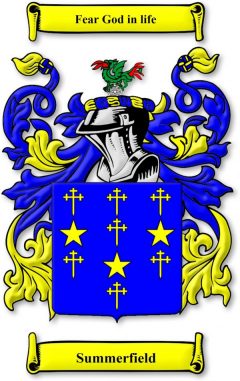The story of our family line begins in the county of Cheshire sometime in the 16th century, where we lived and worked almost exclusively in the farming community. We stayed there until the very early years of the 19th century when my 3rd great grandfather John Summerfield chasing better employment prospects made the journey across the county boundary to neighboring Lancashire and settled in Manchester. John’s extended family largely stayed around the Manchester area until my great grandfather William Summerfield, a merchant seaman, married a girl from West Hartlepool in 1881 settled there and brought up his family. He was not the first Summerfield family member to make the move to West Hartlepool as you will see, but he was the first direct descendant. My children were both born in the area, until I also followed career prospects and moved us all down to the south of England in the late 1970’s, settling in Cambridgeshire first of all. I have ended up in Buckinghamshire and my daughter Sam and son Andy are currently living in Dorset with their families.
But, back to Cheshire where the story first unfolds.
By the early 1600s Cheshire had established its own gentry, and although many were descended from Norman stock they had made their money from the Anglo Saxon farms and culture. The English Civil War in 1642 was a showdown as divided loyalties tore apart the emerging cohesive social fabric. Peasant and aristocrat allied with either Royalist or Parliamentarian causes according to conscience and almost irrespective of social status. Oliver Cromwell completed his rise to power in 1649, with Charles I losing his head. In August 1655, by the order of Oliver Cromwell England was placed under military rule and Cheshire, Lancashire and North Staffordshire were governed by one of Cromwell’s Major Generals. Eventually military rule ended in 1658 and the monarchy was restored with the ascension of King Charles II of England in 1660.
But centuries of relative continuity for the farmers were about to change again, from a slow almost imperceptible evolution, where generations of Cheshire families and their ancient ancestors had worked the land and nurtured their cows with a repetitious regularity, the stage was set for the self sustaining economic growth of the industrial revolution. In 1650 the first ship loaded with Cheshire cheese sailed from Chester to London. So popular did it become that within a few years several pubs in London were called The Cheshire Cheese. Salt had also been long worked in the area, it was obtained from rock salt and saline springs with the principal works being at Nantwich, Northwich, and Winsford. Coal and ironstone were worked in the districts of Macclesfield and Stockport. There were also manufacturers of cotton, silk, and ribbons, carried on chiefly in the towns in the east of the county.
By the end of the 17th century, farming was largely about self sufficiency in food, grain for the people and hay for animals, it was also becoming well practiced at the specialisations which produced useful trading surpluses. All the farms processed hemp and flax into twine, ropes and linen, and specialist builders, tailors, butchers, wood workers, leather workers and blacksmiths were established. Agricultural surpluses became more readily available in the markets to feed these new artisans and by 1700 this new middle class had blossomed. As the population of London and other cities increased, food supplies had to be brought in from further and further away, with Cheshire being a major beneficiary of these new markets.
At the end of the 18th century, land enclosure and district reorganisations took place. As well as in the local industries, better living in the industrial towns. However, industrialisation also brought benefits to Cheshire. The completion of the Trent and Mersey Canal in 1777 and innovations such as the Anderton Boat Lift, allowed Cheshire cheese and salt to become major county exports.
Parish Registers are records of baptisms, marriages,and burials made by the Church in England and Wales, and Non-Parochial Registers are records of baptisms, marriages and burials made by Methodists, Wesleyans, Baptists, Independents, Protestant Dissenters, Congregationalist, Presbyterians, Unitarians, Quakers (Society of Friends) in England and Wales. In 1538, Thomas Cromwell issued a Mandate that ministers of parish churches were to record baptisms, marriages and burials occurring at their church. These records were to be stored in a ‘parish chest’. Often written on loose sheets, very few of these records survive.

In 1598, Elizabeth I ordered that the loose leaf registers were to be transferred to a parchment book, especially those since the commencement of her reign in 1558. Hence it is often found that some parish registers start from this date. These registers have baptisms, burials and marriages in the same volume, but mixed up together in a chronological order. A copy of a year’s entries would be sent to the diocesan bishop. These are called Bishops’ Transcripts. Some still survive and are a useful substitute if the Parish Register no longer exists. In the following centuries various Acts of Parliament and Ordnances changed the structure of the records and how the events were to be recorded; some impositions were intended to raise revenue by way of tax. Because of the latter impositions, the English Civil War, and clandestine marriages, it is often found that some events were not recorded in the registers or they have been lost or destroyed.
In 1754, Hardwick’s Act introduced a specially printed register for marriages, and George Rose’s Act, 1812, introduced separate baptism and death registers with headings for each piece of required information. Prior to this, the event would be recorded in many different ways depending on the officiating minister.
